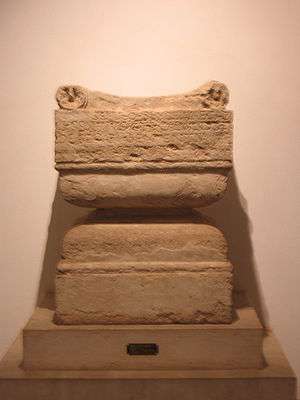Si deus si dea
Si deus si dea is an Archaic Latin phrase meaning "whether god or goddess". It was used to address a deity of unknown gender. It was also written sive deus sive dea, sei deus sei dea, or sive mas sive femina ("whether male or female").
The phrase can be found on several ancient monuments. Archaic Roman inscriptions such as this may have been written to protect the identity of the god if Rome were captured by an enemy.[1] The construction was often used when invoking the god of a place (e.g., "Be you god or goddess who reigns over Carthage, grant us..."). Historian Edward Courtney claimed it was "intended to cover all bases as an acknowledgement of the limitations of human knowledge about divine powers".[2]
Monuments
Altar to the unknown divinity

In 1820, an altar was discovered on the Palatine Hill with an Old Latin inscription,[3]
- SEI·DEO·SEI·DEIVAE·SAC
- G·SEXTIVS·C·F·CALVINVSPR
- DE·SENATI·SENTENTIA
- RESTITVIT
which can be transliterated into the modern form as[4]
- Sei deo sei deivae sac(r + dative case ending o [masc.] / ae [fem.])
- G(aius) Sextius C(aii) f(ilius) Calvinus pr(aetor)
- de senati sententia
- restituit
and translated as
- Whether to a god or goddess sacred,
- Caius Sextius Calvinus, son of Caius, praetor
- by order of the Senate
- restored this.
The altar was dated as a late Roman Republic restoration of an Archaic original. In the 19th century it was misidentified as a famous altar to Aius Locutius.[5] The real identity of the divinity cannot be known, as it did not specify whether it is a god or a goddess. The praetor Caius Sextius C.f. Calvinus may have restored an earlier altar reading "sei deo sei deivae",[1] or he may have been restoring an altar that had been left to decay, while the god or goddess it was dedicated to had been forgotten.
Ferter Resius
Close to the site, four inscribed columns were found dating to the Julio-Claudian period. Column A (now missing) read "Marspiter," or "Father Mars" in Archaic Latin. Column B reads "Remureine," which possibly means "In Memory of Remus." Column C reads "anabestas," possibly referring to a goddess named Anabesta,[6] or else to the Greek anabasio ("to go up") and interpreted as a reference to Remus' scaling of the Roman walls. Column D, the longest inscription, reads:
- Ferter Resius / rex Aequeicolus / is preimus / ius fetiale paravit / inde p(opulus) R(omanus) discipleinam excepit.
Livy ascribed the institution of the fetiales to Ancus Marcius and claimed that the ius fetiale came to Rome by the Aequicoli.[7]
See also
References
- 1 2 3 Description of the Altar to the Unknown Divinity, found at the Palatine Hill Museum.
- ↑ De Numinibus, essay by Mauk Haemers
- ↑ Sandys, Sir John Edwin (1919). Latin epigraphy: an introduction to the study of Latin inscriptions. Cambridge: Cambridge University Press. p. 89.
- ↑ Description of the altar at University of Texas at Austin' Digital Archive Services
- ↑ Rodolfo Lanciani, Pagan and Christian Rome, 1892
- ↑ Internet Archive: Details: Thesaurus linguae latinae epigraphicae [microform] ; a dictionary of the Latin inscriptions
- ↑ Livy, Ab Urbe Condita, 1.32.5
Further reading
- Alvar, Jaime, 1988: "Materiaux pour l'etude de la formule sive deus, sive dea" Numen 32,2, 236-273.